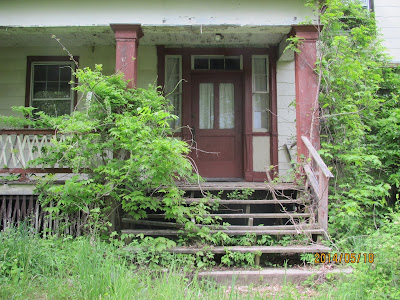An historic home on the Wallkill farm of Samuel Campbell (sold in 1793) is slated for demolition.
Noted historian, Mildred Parker Seese, included the "Old Milliken Homestead" in her book of Old Orange Homes.
 |
| Undated Photo from Seese, Old Orange Houses Volume I, 1941, p10. Note diamond-shaped window in attic. |
This is the home that still stands on the northeast corner of Route 208 and Coleman Road in Montgomery, New York. It is in disrepair and unoccupied. The property was once part of the Samuel Campbell farm (1773-1793) and is currently part of the Bruderhof Community. It is slated for demolition.
 |
| Picture taken by the author in March 2015. Looking from the west. Note diamond-shaped window matching the house in the Seese photo. |
 |
| Photo taken by the author in May 2014. Already in advanced state of decay. |
 |
| Photo taken by the author in May 2014. Front entry. |
In a prior blog, I described the ownership history of this property. It was originally part of a large 2000 acre patent granted to Archibald Kennedy in 1719. The Campbell-Barkley deed states that the part of the Kennedy patent that eventually came into Campbell hands, was 'granted' to Thomas Goldsmith (a 'Thomas Goldsmith' appeared twenty-one times in the Colden Store DayBook of 1767-8) who in turn 'granted' it to David Baldwin (could this be the same 'David Baldwin' of Newark Mountain where Samuel Campbell was living prior to coming to New York?). Samuel Campbell purchased it from Baldwin, probably in the late 1760s.
The location and boundaries of this property can be pinpointed thanks to the detailed description in the deed and the still existing stone walls that bordered the early farms.
 |
| Property Lines (red) of Campbell Farm in 1793 deed. The 'Milliken' home is just to the north of the 'Coleman Rd' label. |
Barkley already owned property to the east of this parcel. In 1826 his son sold a parcel of land to Susan Bowne which included the part of the Campbell parcel west of Route 208.
 |
| Barkley sale to Bowne in 1826. 1793 boundaries of Campbell farm in green.The boundaries are plotted on the 1862 farm map of Montgomery, NY. |
By 1862 the eastern part of the Campbell farm was part of the Peter Eager estate. He is still listed as the owner in the 1875 Atlas. The 1903 Atlas refers to the home and property as "Maple Lawn" owned by Chas. Coleman.
Milliken property appears to the west of the Bowne property on the 1862 farm map of Montgomery. The 1793 deed also described Milliken property abutting the Campbell farm on the north (above the Peter Eager parcel shown above.) However, I have found no reference other than Seese that the Millikens owned the property on which the 'Milliken' home stands. Could she be mistaken? Is this really the Peter Eager house built onto or near the original Campbell homestead?
Stay tuned.







